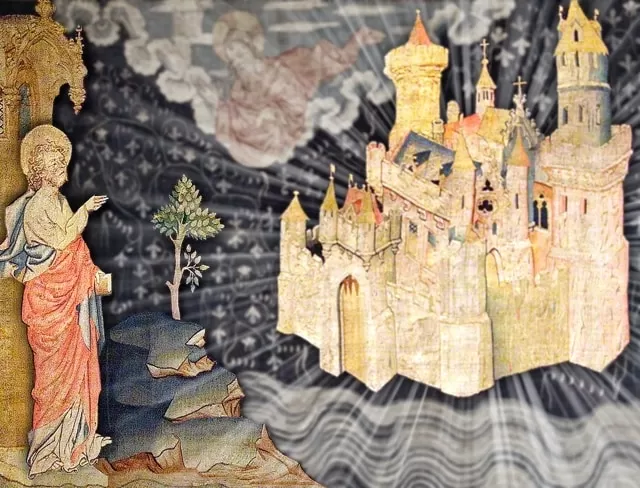
I posted this yesterday as a response to Kaz’s probing question about the presence of the “holy city, new Jerusalem” in the new creation that appears to John after the final judgment. I won’t repeat the argument of “Why does the holy city Jerusalem descend from heaven twice at the end of Revelation?”, but I think that Kaz has drawn attention to something important, and I want to highlight the significance of the reference back to the letters to the churches in Revelation 21:6-8:
And he said to me, “It is done! I am the Alpha and the Omega, the beginning and the end. To the thirsty I will give from the spring of the water of life without payment. The one who conquers will have this heritage, and I will be his God and he will be my son. But as for the cowardly, the faithless, the detestable, as for murderers, the sexually immoral, sorcerers, idolaters, and all liars, their portion will be in the lake that burns with fire and sulfur, which is the second death.” (Rev 21:6–8)
I agree with Kaz that the description of the new Jerusalem in 21:2 as being “prepared as a bride adorned for her husband” looks, at first glance, out of place in a description of the new creation. It takes us back to the climax to the period of suffering witness in Revelation 19:6-8 (“his wife has prepared herself”) and the inauguration of the new political-religious order in the thousand year period. This was Kaz’s original point, and it made me look at the passage again. And now again.
The same point could be made about the rewarding of those who conquer in Revelation 21:6-7, and I wonder if the reader is not already here being directed back to the circumstances faced by the historical churches in Asia Minor. In that case, the reference to the lake of fire which is the second death in 21:8 does not so much reiterate the consignment of those whose names are not found in the book of life to the lake of fire in 20:14 as recall “what the Spirit says to the churches. The one who conquers will not be hurt by the second death” (Rev 2:11).
But this is important, isn’t it? It suggests that the promises made to the churches in the seven letters find their fulfilment not in the heavenly marriage of the bride and the Lamb or in the heavenly reign of the martyrs throughout history, but in the “earthly” life of a new creation after all evil has been destroyed in the lake of fire.
So here we have a positive reason for including the descent of the new Jerusalem to be part of the new creation. It is the means by which the martyrs, the bride of the Lamb, get to experience the renewal of full created life (eg., drinking from “the spring of the water of life without payment”) after the long reign in heaven.
The triumphant wedding of the bride and the Lamb brings to an end the period of tribulation and inaugurates the reign of Christ in heaven with the martyrs, but the bride (who remains a bride) is then seen descending out of heaven from God on two distinct occasions, for different reasons.
There is the final re-uniting of heaven and earth in the new creation, with the dwelling place of God coming to be with humanity, and the rewarding of those who have conquered with the renewal of created life. There is no mention of walls and gates in this context because everything evil or dangerous has been incinerated in the lake of fire.
But there is also a historical anticipation of that final arrangement represented by the descent of the holy city to rest on a high mountain, analogous to Ezekiel’s vision of restored Jerusalem, replacing the corrupt and corrupting city of Rome on its seven hills, with walls and gates, in the midst of hurting nations (Rev. 22:1-2). The nations of the Mediterranean world, in other words, will no longer be misled by the “great prostitute… with whom the kings of the earth have committed sexual immorality” (Rev. 17:1-2). Instead they will walk by the light of the glory of God and of the Lamb (Rev. 21:23-24). In a nutshell, Christendom.
Although sin still present in the world, the gates are kept open in order that the kings of the earth (this is a political-religious vision) may bring tribute in (Rev. 21:24-26). But nothing unclean, detestable, or false will enter the city (Rev. 21:27).
Thank you for your detailed response, Andrew. I find this to be a very stimulating topic.
So you are saying that there is only one wedding of the Lamb at the beginning of the Millennium, but it is shown to be descending to earth twice, once as a historical anticipation (21:9) and then as the final real descending at the renewal of heaven and earth (21:2)? Now I can understand the meaning of the second descent of Jerusalem in 21:2 much clearer (and it seems to do justice to the narrative continuity of 20:11-21:8), but this in turn creates a problem with the first descent of the heavenly Jerusalem.
As you stated, the early martyrs will be resurrected when pagan Rome is defeated and they will reign with Christ in heaven, not on earth. But this seems to contradict John’s vision of the heavenly Jerusalem descending to earth at that time (21:9). In 21:9-22:5 the city is clearly located on earth, interacting with nations, and both Christ and the servants of God (presumably the martyrs?) dwell in it (22:3-4). So I am struggling to grasp what you mean by “historical anticipation.” Could you please clarify?
@Kaz:
Again, a good question. Very productive. It needs a proper response. As you can see, I’m making this up as we go along!
Recent comments